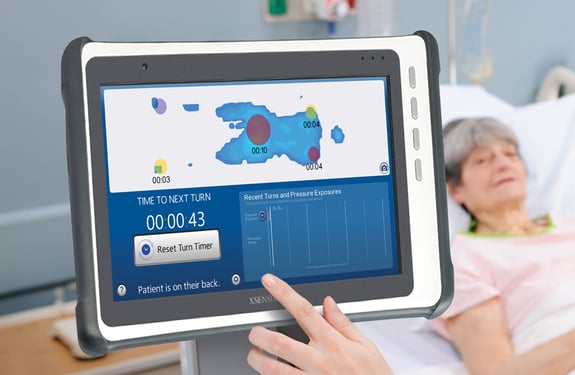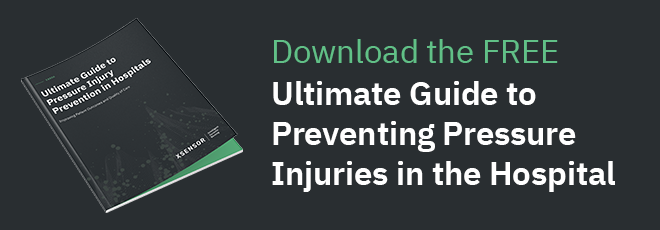
Pressure Injury 101: Stage 1 Pressure Ulcers
Here are the signs of stage one ulcer development.
It’s no secret that pressure sores are a major issue in hospitals and health care institutions nationwide. When it comes to pressure injury development in hospitals, people across the United States are certainly not alone. Every year, 2.5 million people develop hospital acquired pressure ulcers (HAPUs)—and 60,000 die of complications. Of high concern: up to 45% of these HAPU injuries are developed on the surgical table of operating rooms. (Berlowitz D, 2014, p.11) With pressure sores and injuries being such a prevalent issue, we must pay attention to the early signs of their development; this is key to prevent them from worsening to further injury and even death.
Of all the factors that go into pressure sore development, one thing is clear: by learning to identify the early signs of a bed sore and take appropriate action—particularly during the first stage of its development—more serious pressure injuries can be limited.
At XSENSOR, our technology and products help healthcare professionals monitor risk of pressure ulcer development from the very beginning. We’re working toward a reality where stage one pressure ulcers are the only injuries we see—if that.
What are the stages of a pressure sore?
Pressure sores—injuries to the body coming from prolonged pressure exposure—fall into one of four main categories, or stages. Whether a stage one ulcer, where the skin is just beginning to show damage, or a stage four ulcer, with open wounds, sores and signs of infection—they all need to be treated with urgency. Here are the four stages of a pressure sore.
Stage 1 Pressure Sores and Ulcers: Early on in pressure ulcer development, the skin is developing injury. While no open sores or broken skin are present yet, skin may appear redder, warmer or firmer than usual. Known as a non-blanchable erythema of intact skin, the color change may indicate the beginnings of a serious injury to the deep tissue.
Stage 2 Pressure Sores and Ulcers: This is where the true sore, or ulcer, develops as a break in the skin. It is often very painful, and can create serious damage within the skin. Known as partial-thickness skin loss with exposed dermis, these bed wounds can quickly become something worse.
Stage 3 Pressure Sores and Ulcers: In stage three, the pressure ulcer has developed into the soft tissue underneath the skin. Known as full-thickness skin loss, this stage may showcase a deep wound, especially in an area with more adipose tissue.
Stage 4 Pressure Sores and Ulcers: By the final and most serious stage of a pressure sore, the skin may have receded into the muscle tissue or the bone, causing lasting damage to the skin and underlying areas. Known as full-thickness skin and tissue loss, this stage can involve visible or palpable fascia, tendon, muscle and bone.
 What does a stage one pressure ulcer look like?
What does a stage one pressure ulcer look like?
Stage one pressure ulcers present in a number of ways, far before the skin breaks. Sometimes, they show up as a blood-filled blister, while other times manifesting as an area of skin that doesn’t turn white when pressed upon. The lack of visible skin damage isn’t necessarily cause for relief— stage one pressure ulcers can still cause tissue injury.
Here are some signs to keep in mind when monitoring for a stage one pressure ulcer:
- The skin is discolored: it may be redder or even bluer than is typical. (In more dark-skinned patients, the skin may turn purple.)
- The skin feels warmer to the touch.
- The skin feels firmer or softer in one spot than usual.
- The skin is itchy and painful.
- When the skin is pressed down on, it doesn’t appear lighter or turn white to the touch.
- The skin is swelling or beginning to show signs of a blood-filled blister.
How to treat a stage one pressure ulcer
Once a stage one ulcer has been diagnosed, there are several immediate actions that can stop its progression to open wound—or decubitus ulcer—which requires urgent wound care.
The first step should always be thorough pressure injury risk assessment using your hospital’s existing assessment protocol/procedure, or better yet, by integrating technology that continuously monitors risk from the beginning of a patient’s stay.
To treat an existing injury, it’s important to reduce pressure on the area of affected skin immediately. This may involve turning the patient and/or using a specific mattress topper or material that helps redistribute pressure on the patient’s skin.
Stage one pressure ulcers require hospital staff to work fast. While the sores need not induce panic, they can become a considerable problem should they move into stage two. That, along with the possibility of already-sustained tissue damage, should encourage health care professionals to immediately implement preventative measures.

Equipment to prevent stage one pressure ulcers
Pressure injuries and ulcers are a serious issue in hospital settings—but by implementing technology that helps stop the ulcers at stage one, your hospital can make great strides in improving patient care. XSENSOR offers continuous pressure monitoring technology, equipping medical professionals with data that aids in the mitigation and complete prevention of pressure injuries. Our technology is designed to prevent injury holistically, and we’re committed to giving medical professionals access to smart technology that results in top-notch care for patients.
Because stage one pressure ulcers can develop quickly, our ForeSite technology is designed to prevent them by working with three main culprits: surgical tables, hospital beds and wheelchairs.
- For hospital beds: Our unique ForeSite Intelligent Surface system has more than 1500 sensor cells on the surface of the mattress or overlay to measure patient body surface pressures, displaying data in real time for continuous monitoring. The system includes AI powered body position tracking and a turn clock to track repositioning that informs better patient care.
- For surgical tables: Our ForeSite OR system carries the same technology through to the operating room, which is excellent for safe positioning and managing risk in longer surgeries.
- For wheelchairs: Our ForeSite SS system utilizes high accuracy sensing to design safe seating for those in wheelchairs.
At XSENSOR, we’re motivated by the same goal that you are: high quality patient care. Our intelligent, dynamic sensing technology gives you the tools to do that work with excellence. Contact us today, and we’ll elevate your standard of care together.
References:
Berlowitz D, Lukas CV, Parker V, et al. (2014). Preventing pressure ulcers in hospitals: a toolkit for improving quality of care. Agency for Healthcare Research and Quality. https://www.ahrq.gov/professionals/systems/hospital/pressureulcertoolkit/index.html
Report typo or error by contacting XSENSOR or Murray Vince

